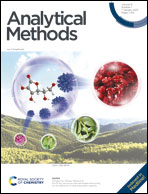An electrochemical biosensor for the detection of aflatoxin B1 based on the specific aptamer and HCR biological magnification
Abstract
Aflatoxin B1 (AFB1) is a highly toxic mycotoxin, which causes severe acute or cumulative poisoning. Therefore, it is important to develop sensitive and selective detection methods for AFB1 for the safety of food and medicinal herbs. Herein, we have developed a “signal-on” electrochemical aptasensor based on the high specificity of the aptamer and hybridization chain reaction (HCR) biological amplification for AFB1 detection. In this work, thiol-modified complementary DNA (cDNA) immobilized on the surface of a gold electrode (GE) served as an initiator DNA. When AFB1 was present, it competed with the cDNA for binding to the aptamers, which resulted in the detaching of aptamers from the cDNA–aptamer duplexes. Then, the single-stranded cDNA acted as an initiator to trigger the HCR signal amplification. Therefore, long double-stranded DNA (dsDNA) products were produced, which could load large amounts of methylene blue (MB) molecules to generate a distinct electrochemical signal. Under the optimized conditions, the proposed electrochemical aptasensor achieved the ultrasensitive detection of AFB1 with a linear detection range of 0.01–100 pg mL−1, and a limit of detection (LOD) down to 2.84 fg mL−1. Furthermore, the electrochemical aptasensor was successfully applied for detecting AFB1 in corn and two kinds of traditional Chinese medicine samples, indicating the potential value for AFB1 detection in practical samples.



 Please wait while we load your content...
Please wait while we load your content...